![]()
CLICK ON THIS TABLE TO NAVIGATE THROUGH STORIES
![]()
Click on the Heart to get back to the main menu
This is story of the children and grandchildren and heirs of Gregorio Villarreal father of many of the Villarreales of the Rio Grande Valley of South Texas
![]()
CLICK ON THIS TABLE TO NAVIGATE THROUGH STORIES
![]()
Click on the Heart to get back to the main menu
Tell me what you think!!! and if your related Lets have a reunion, Nancy Villarreal Schultz and Nicole Villarreal from California are ready to come down and meet the whole Villarreal Klan.
Early Colonial Life in South Texas
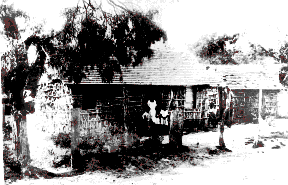
By the 1700's the Villarreales were a very well established and respected family in what is now Northern Mexico and South Texas. Almost any document in early archives of the Spanish Colonial period mentions the Villarreales almost always as military officers, clergy, political figures or established ranchers.
The Villarreales colonized and settled in Northern Mexico and South Texas. All were from the Diego Villarreal family that settled in Salinas Victoria . I have taken inventory of all the birth and marriage records of the 1740's and1750's and have found many Villarreal families. It is from these original colonial families that most all the South Texas and Northern Mexico Villarreales came. From this family group all of the Villarreales in the Rio Grande Valley can trace their roots, including the Villarreal families that founded Matamoros Mexico on the south side of the River from Brownsville Texas .
During these first years of colonization the women and children lived in the villages of ancient Reynosa and Camargo across the Rio Grande from the towns of Penitas, Abram and Rio Grande City. The men worked the Ranches during the week or for extended periods and returned to the village on weekends or during certain seasons, leaving workers to tend to their herds of cattle or goats. After the Indian population and threat was eliminated the families eventually moved on to their Ranches which were officially granted to them by the King of Spain in 1767 under the Acts of the Generals Visit.
Juan Antonio Villarreal a Spanish soldier is one of our earliest known Texan ancestor he was a decendent of Diego Villarreal. He arrived in the Valley area with his wife in 1747. In 1778 his son Jose Antonio was killed by an Indian tribe known as the Tampacuaces. In 1779 according to the civil records in the Archives of Reynosa an executive order was issued by the local Spanish Government instructing the Villarreales and others concurring to commit atrocities against the Tampacuaces to cease such actions. It seems that the family was avenging the death of Don Jose, and at the same time showing the Indians that the Villarreales were a family who's land or path was not to be crossed. Later stories told by old timers reflect this pattern, tresspassers were not welcome on Villarreal territory or they would pay the price.
Reynosa colonist's received 81 Porciones. Among these Grantees were many of our ancestors, not only of the Villarreal last name but families of the wives which the Villarreales married into. The Porciones received were on the North side of the Rio Grande and located in present day Hidalgo and Starr Counties. Each portion of land was approximately 2 miles long by 16 miles deep with the short side fronting the River so that each colonist would have water and river flood plain for farming and land for ranching. These families can be given credit for being the first to experiment with stock breeding, horticulture, irrigation and responsible for the establishment of schools and churches in the Rio Grande Valley As far back as the 1740's.
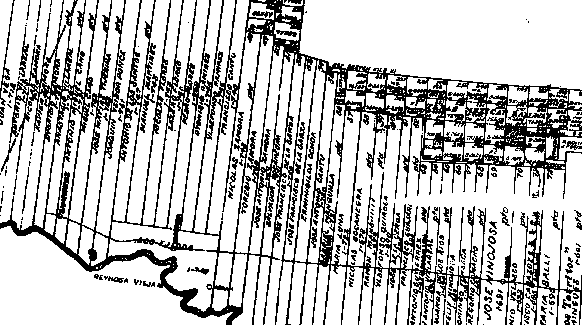
Partial Map of the Reynosa
Porciones![]() Back
to Table
Back
to Table
![]()
After colonization these pioneer families were scattered among the ranches throughout South Texas and Northern Mexico, the Spaniards were very close knit and the ties of friendship and of family were close, so that the home life at all the ranches was very similar. Everyone knew everyone else, and though the means of communication and transportation were scarce, there was a feeling of kinship and unity among all the early settlers. There was little or no English culture introduced into the area until the 1900's so there was hardly any difference in the way of life between people on the Mexican side of the Rio Grande and the native inhabitants on the North side of the River.
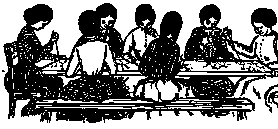
The grandmother was the most important member of the family it was her duty as it had been her grandmothers to teach all the young ladies the art of survival and their important role in this very structured society. This tradition was passed on from generation to generation and was a family tradition up until a generation back. A schedule of an ordinary day in the home would be: Uncover the fire, make the coffee milk the cows, put the nixtamal on the fire, Put the beans to cook, (this sounds alot like my grandmothers house). Customs and traditions haven't changed much but our generation will probably never again have the beans and tortillas on the table at every meal like our ancestors," what a shame! Its our choice to keep traditions alive or let them die along with the memory of these colonist's. I'm sure they often thought about the fate of their future generations.

The pioneer men worked long hard days in order to keep food on the table and for many generations did their best to keep the land which they had been granted in the 1740's but as the families grew they slowly divided their portions and soon these huge ranches became more numerous and smaller. The settlers adapted to life in the new colony fairly well and also adapted local Indian food and customs into their society and developed a new culture that still thrives among the residents of South Texas and Northern Mexico.
By the 1800's many of the families had moved to the ranches and the decendants of the original colonists scattered throughout South Texas.Their children married into other colonial families. There is an old saying in our local culture and Im sure youve heard it before. "Son de familia buena", "They are from a good family". It stems back to these colonial families. Children of good families married children of other good families. This tradition kept the Spanish blood lines pure and assured continued wealth and control for the core group. The Villarreales were considered a " familia buena".
![]()
Note: These are ranches that have direct relationship to the my personal family tree. I would like to add additional ranches as more information is sent to me:
Rancho Guadalupe /Torero (the Bullfighter) is located in Northwestern Hidalgo County Texas, on the South Side of FM 1017. This ranch is located in the San Ramon Land Grant which was granted to Julian Farias by Spain in 1804. This ranch has been spoken about in Villarreal oral history as being the place where J. Manuel Villarreal was buried (he was born in 1796). It was at this ranch that Manuels son Gregorio Villarreal was raised. Gregorio was born in 1820 his mother was Maria del Refugio Cisneros daughter of Jose Antonio Cisneros of Camargo. The Villarreales also originated in Camargo but Manuel's father Juan Antonio was a Spanish soldier stationed at Reynosa he was granted porcion 65. Why Manuel and his family ended up in this part of the country is a mystery but Manuels children and grandchildren concentrated in this area in the mid 1800's. Hidalgo County warranty deeds reference the purchase by Gregorio Villarreal from Juan Farias. The Farias were related by marriage and were also related to the Longoria family.
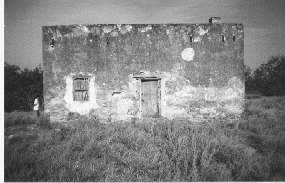
THE VILLLARREAL HOUSE (1820) Photo taken 1996
Manuel's son Gregorio Villarreal built a stone house of sillares (caliche limestone blocks) found on the site. The house became the main ranch house. It sits at the top of an outcrop and measures approx.40 x 20 feet with a single wooden door and wood framed window in front. It has one chimney and a flat roof. The roof is covered with chipichil (a mortar made sand or gravel, quicklime and goats or cows milk bound with cotton fiber). The roof structure is made from saw cut wood beams spaced about two feet apart with saw cut wood decking and bricks laid over the decking. The ends of mesquite beams protrude about four feet below the East roof line. This was probably a front porch at one time. The doors and shuttered windows, were made of hand carved mesquite. Door hinges, latches and keys were probably made by the ranch blacksmith. The latches have hand crafted designs which reflect a good example of the vernacular artwork of the times. The door and window lintels are made of large hand cut mesquite beams laid into the structure during construction. Then kitchen was probably a thatched roof jacal structure with a dirt floor, separate from the main house. A large horno, or oven was usually built outside. It was dome shaped and used for cooking various foods. The house is over 160 years old and is one of the oldest permanent structures in the Rio Grande Valley. The well located directly to the south west of the house is about 10 feet lower in elevation than the house. It is one of the finest in the ranch country. About 10x10 by 60 feet deep it is lined with hand cut sillares all the way down. Next to the well is a large tank with a small holding pileta (small pool) where the water was placed before it filtered down to the main tank. The main tank was very well thought out since its walls are supported with stone buttresses. It was built with a long shallow stone watering trough extending out about 40 feet or more to the west. The well was know as La Noria Communidad. The Architect of these structures had very good knowledge of building systems and could have very easily constructed a Mission with this knowledge. There is another stone house near the Villarreal house this house had a pitched roof made of machine cut lumber and factory made wooden shingles probably hauled in from Corpus on wagons. It was probably built around 1860.
Manuel Villarreal was the son of Juan Antonio Villarreal and Andrea Zamora records in the archives of Reynosa show that they were married on August 15, 1796. There is some conflict as to where Manuel grew up oral history states that he lived or frequented a very old Ranch and Spanish Fort in Live Oak County, Texas. The ranch was known as La Posta Ramirena or Fort Ramirez on Ramerina Creek in South Eastern Live Oak County Texas north of Corpus Christi (Now Primm pasture or the old Dobie Ranch). These fortifications and settlements on both sides of the Nueces River were abandoned due to Indian Raids. The Villarreales also settled along the Nueces strip, they were probably soldiers stationed at this desolate Outpost/Residence. Manuel was a Rancher and a Vaquero he married Maria del Refugio Cisneros Daughter of Jose Antonio Cisneros and Angela Perez on January 7th, 1818. Manuel's mother was Andrea Zamora. Andrea was the daughter of Jose Antonio Zamora a very prominent Spanish colonist who was granted Porcion 51 under the Jurisdiction of Reynosa. Manuel's family were the first colonists of Camargo and Reynosa. Manuel was the great great grandson of Captain Bernabe Villarreal son of Captain Diego Villarreal.
These people were the true survivors they were the first to endure the Comanche Indian raids from the North. Their climate was a little more severe than those Ranches along the Rio Grande but these men were as tough as the leather chaps they wore as they traversed the South Texas brush country. Although exact family records have not been saved from this epoch, oral family history (De Luna's interviews, 1976) and later census records placed Manuel's birth around 1796. (US Census, Hidalgo Co. 1870:11/9).
While Manuel was just an adolescent, Mexico fought for its independence from Spain in the Revolution of 1810. Having come from a military family background, I am curious if the Villarreales were Loyalists or not. After the war ended, the new Mexican government tried to encourage greater colonization of its northern provinces, Coahuila and Texas. In 1820 Moses Austin was permitted to settle immigrants from the United States into Texas.Manuel tended cattle in Porciones 49,50, and 51 of Reynosa these tracts were originally granted to Jose Antonio Zamora and Toribio Zamora his grandmothers family. This vast stretch of arid land extended from the North side of the Rio Grande to the lakes called Sal del Rey and La Sal Viejo. Oral History tells that Manuel was killed by Indians around the present day King Ranch and is buried at Rancho Santa Guadalupe, In Northwestern Hidalgo Co. 2.5 miles southeast of Puerto Rico on the South side of FM1017 His son Gregorio built a stone house at this location which still stands today (Vol.A page 385 Hidalgo County Deed records).
Manuel was thought to been a member of the Compania Volante or Flying squadrons which patrolled the Rio Grande Region during this period. Many of this family were still in Military service during this period. The Compania Volante or Tejano flying squadron, predated the Texas Rangers.
Gregorio Villarreal (Father of many of the Villarreales from South Texas)
Gregorio was born in 1820 and must have married young because in 1847 after having eight children from his first wife he was left a widower. He then married Nasaria Longoria and had nine children from Nasaria. All lived in the stone house until about 1875 when Gregorio moved with some of his children west of this ranch to a 13,000 acre tract of land and started Rancho San Francisco El Americano.
After Gregorio moved from Guadalupe some of his older children remained at Guadalupe Ranch. His son Hilario continued to live in the stone house until 1897 when he sold 1,502 acres of this ranch to Jesus Maria Vela (WD G,554-555 Ja. 10, 1897. Hilario to Jesus Maria Vela). It is unknown how much of a share the Villarreales had in this ranch or how they got there but it appears that their roots were well established there in the early 1800's. Manuel Villarreal was killed by Indians in the King Ranch area and was laid to rest at Guadalupe Ranch. This probably means Manuel also lived at Guadalupe, Manuel tended cattle on porciones 49,50,& 51 on land granted to Jose Antonio and Toribio Zamora his Grandmothers family. Perhaps family brought him to Guadalupe or maybe he just ventured out to seek his own fortune. These were the Northern frontiers of the Spanish empire and only the brave and strong in spirit ventured Northward. The Villarreales ventured as far north as Nueces, Kennedy and Live Oak County. It was in Live Oak County where Gregorio Villarreal died and was buried.
The Villarreales continued living in the area and married into the Longoria and Bazan families whom also had ranches in the Guadalupe and San Ramon Grant area. Many still reside in the area, In 1892 many of the Villarreales picked up roots sold El Americano Ranch as well as much of Guadalupe and many family members relocated to Rancho Ojo de Agua (Abram) near Mission Texas. Many of Gregorio's Children and Grandchildren are buried at the San Jose Cemetery at Ojo de Agua.
This is all I know of the Villarreales at Guadalupe Ranch. My personal opinion is that the House was built around 1820 by Manuel not Gregorio and that the Villarreales were at Guadalupe Ranch for at Least 90 years until they sold out and moved back South closer to the border. The U.S. invation of former Mexican lands made it very difficult for many of the Spanish colonial families to hold on to ther lands. The language barrier coupled with political and cultural differences led to the loss of hundreds of thousands of acres, this was the case for the Villarreal family. There was great trouble in the area among the Spanish colonist's and the new influx of Anglo settlers. The Texas rangers favored and defended their foes, as a result many inocent Mexican Americans were killed or robbed of their lands. Not all Rangers were disliked many were friends of all and treated all equally. These families ended up moving close to the border communities where they were better represented in numbers and where they also held ranching lands more securely. This was also the beginning of the end of our rich ranching heritage.
![]()
This ranch is of particular interest to our family because it is the ranch most mentioned in oral family history, Francisco Villarreal my great grandfather was born there as well as Gregorio Villarreal my Grandfather. The name is said to have come from an incident that occured there. When the first Americans came into the area this was the place where an American man was found dead. An affidavit filed at the Hidalgo County courthouse in Edinburg, Texas by Francisco Villarreal dated October 5, 1911 in which he and several others describe this ranch and certain occurrences that happened here. Francisco wrote the following " During the year 1875 my father (Gregorio) located upon this 13,000 acre tract of land in Northern Hidalgo County. My father built two houses and several outhouses, he dug a well and set up sheep and goat pens and moved our family thereon to live. My father was using this property as a ranch, raising stock. In 1892 my father sold part of the ranch to Mr. Ramon Vela. Two or three days after our departure from the ranch and immediately before Mr. Vela took possession, someone set fire to the houses and burned them down to the ground. Also the well curbing was knocked in and filled the bottom of the well. This ranch is located in Hidalgo County Texas directly under a large portion of land known as Rancho San Ramon. Later it was known as Sam Lane Tract, It is believed that not all the ranch was sold to Mr. Vela because in 1889 Francisco and Juana Villarreal sold 1/2 of their share of 320 acres to Jose Longoria. This land was purchased by his son in law Clemente Reyna and Francisco Villarreal in May of 1880. Another son from his first marriage Hilario Villarreal Y Garza sold 1/2 of his share of the rancho which belonged to Gregorio Villarreal. Clemente Reyna was Married to Refugia (Maria del Refugio) Villarreal who was Gregorio's daughter. This ranch still exists and is owned by the Garza family of Edinburg another part is believed to be owned by the Franco family and still bears the name Rancho El Americano. The old well became a legend and is still in existence The family moved to a Ranch called Jardin de las Flores now Bensten State Park which belonged to his wife"s family.Why the family left this ranch is not certain but that is how the family ended up closer to their final staging ground Ojo de Agua.
![]()
After the Villarreales left the Rancho El Americano they moved to a ranch called Jardin de Las Flores now present day Bensen State Park. The Ranch was on a grant which belonged to the family of Gregorio's wife Nasaria Longoria who was a decendent of the original grantee. This ranch was adjacent to Los Ejidos de Reynosa. This was probrably just a temporary move before moving on to Ojo de Agua.
![]()
Los Ejidos de Reynosa Viejo known as the town commons of the ancient city of Reynosa it was first established in the 1740's this land was used in common by all the villagers for grazing and for cultivation. It was separate from the porciones which were granted to the settlers as private holdings. Each of the old Spanish River Towns were laid out with a certain amount of common land known as the Ejidos. The town commons of Reynosa extended from Penitas to Abram to Benson State Park in the Us and an equal distance on the Mexican side.
The town commons was sold to the descendents of the original grantees by the Mexican Government in October of 1836. This land was distributed among the decendants of these colonial families. The right to this property was challenged during the 1930's by the Rio Grande Land and Water Company. All families had to hire lawyers and prove ownership of their lands. It was a very difficult task since the lands had been held by families for nearly 100 years and split up among children in the process. Our family did keep its land and also lost other lands in order to pay for the legal fees. It was during this transitional period that the ranching heritage was being lost. The gringos from up north were taking over the government and we became second class citizens in our own homeland. The pastures were being cleared for farming and the Rio Grande River bottom land owned by our family was ripe for such and endeavour. So the cowboys became farmers and so ended centuries of our ranching heritage.
![]()
Ojo de Agua or Eye of Water appears in several old river ranch maps that date back to the early 1800's it was located on the north side of the Rio Grande River directly east of the old town of old Reynosa. Ojo de Agua is now known as the town of Abram, Texas and is on the banks of the Rio Grande River . The town commons was sold to the descendents of the original grantees by the Mexican Government in October of 1836. The Villarreales moved to this area and established homes. This area, had grown from a ranch to a village since its early colonial days. There is a cemetery in Abram named San Jose Cemetery in which most of the people buried there are relatives of the Villarreales or of families which the Villarreales married into. These are the children of Gregorio Villarreal and Nasaria Longoria as well as the children of Francisco and Juana Villarreal.
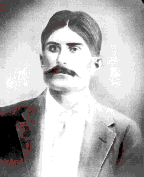
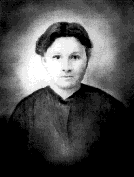
My Grandparents
Gregorio Villarreal andWife Maria Longoria de Longoria (Gregorio son of Francisco Villarreal )
The Villarreal and Longoria families have been intertwined from the early colonial days in the Valley, by the marriage of Florentino Ochoa and Maria Olivares and Jose Antonio Villarreal and Maria Gertrudis Vega, In the 1760's and 1770's. The families were granted thousands of acres in the eastern sector of the Ejidos, and their heirs inherited vast amounts of property in the porciones, the porciones were #39, 65, 42, 47,48,74,77, and 80. Over the years most of the property was lost during the time when this area became part of the United States and the families had to prove that these properties belonged to them. Many documents show, these families would give up thousands of acres to lawyers who in turn would prove that the property was theirs. Most documents were signed by an X and most people didn't know what was happening to their land holdings. It is sad and very hard to see these legal binding documents in which the lawyers took almost all the land because of our ancestors ignorance of the English language. ASI ES LA VIDA! Over the years the family spread throughout the Valley area and into Mission Harlingen, Raymondville,Dallas, Houston,Chicago and throughout California and the USA.
![]()
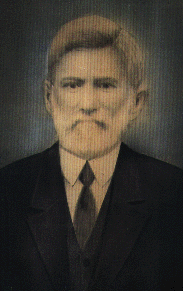
Francisco Villarreal Son of Gregorio (Photo Circa 1890)
Francisco's legend still lives at the rancho Ojo de Agua (Abram Texas). Old timers talk of Francisco on horseback and of his great riding skills. There is a huge mesquite tree on the property where his house stood. This tree is said to be one of the oldest mesquite trees in south Texas over 600 yrs old. It is called (El mesquite de Francisco Villarreal). Francisco was also remembered as a ladies man, he left his first wife Juana Flores for another woman at an older age and had a second family. He is best remembered as a great supporter of education and schools in the ranch area. The first school in Ojo de Agua sat on Villarreal land.
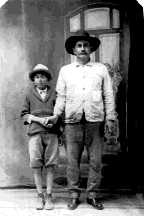
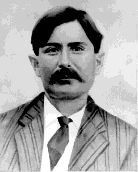
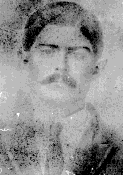
Seferino Villarreal with Roman Pedro
Villarreal Rafael Villarreal ![]() Back to Table
Back to Table
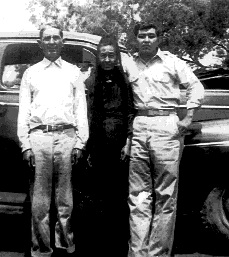
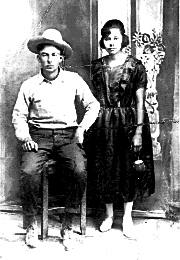
Pedro Villarreal, wife Juanita Garza and Lorenzo Seferino Villarreal and wife Dolores Vega I am lacking a photo of Isidra and Clemencia Villarreal.
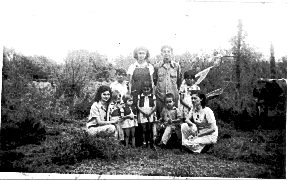
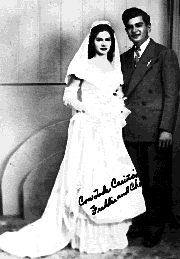
Primos in Ojo de Agua (Abram, Texas) 1939 (I need Names) Leofredo Villarreal and Consuelo Galvan my parents

This is my Familia this picture was taken 2004. Left to right Marina, Natalie,Shane, Justin,Danny Jr.,Me Danny Sr.,and My wife Blanca